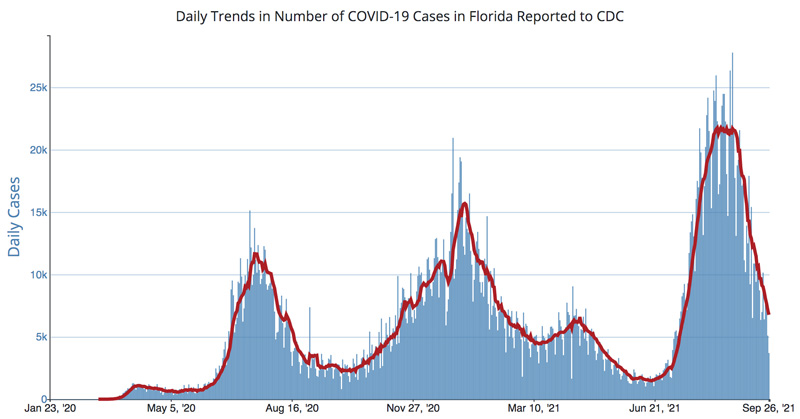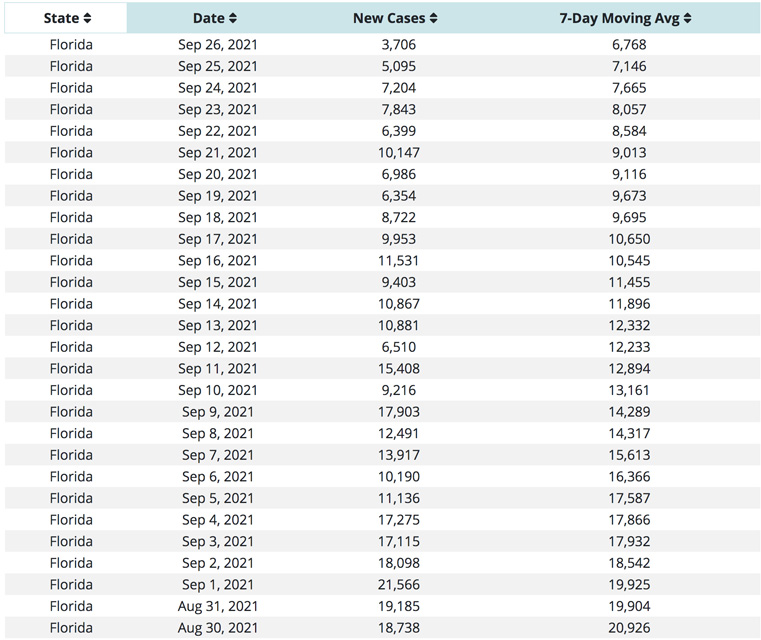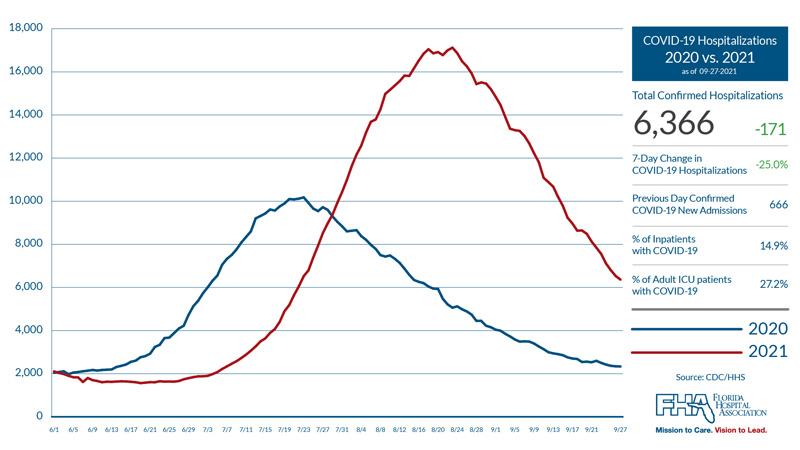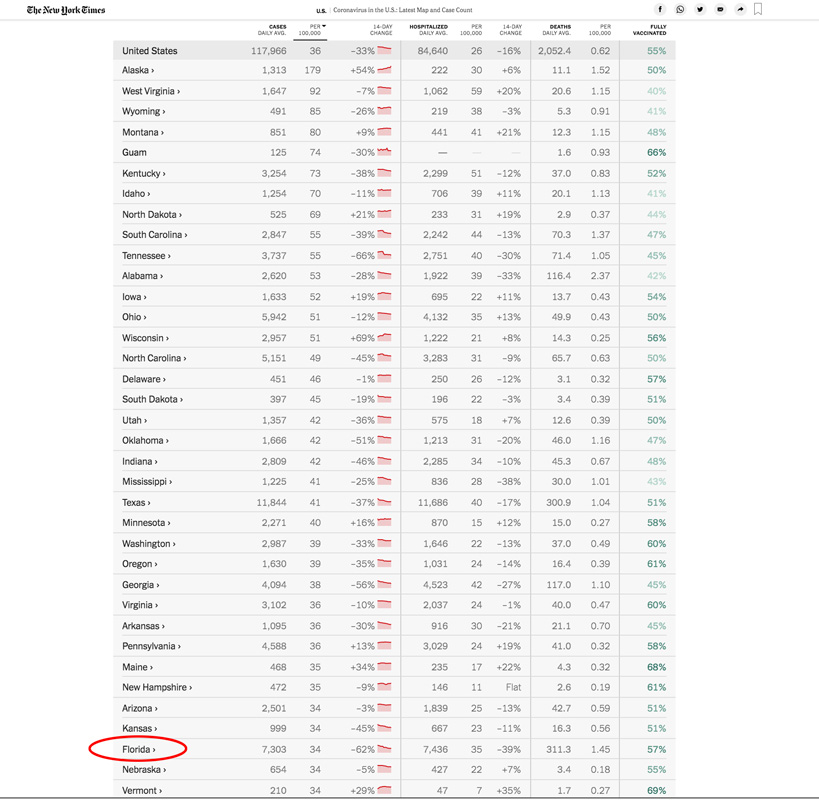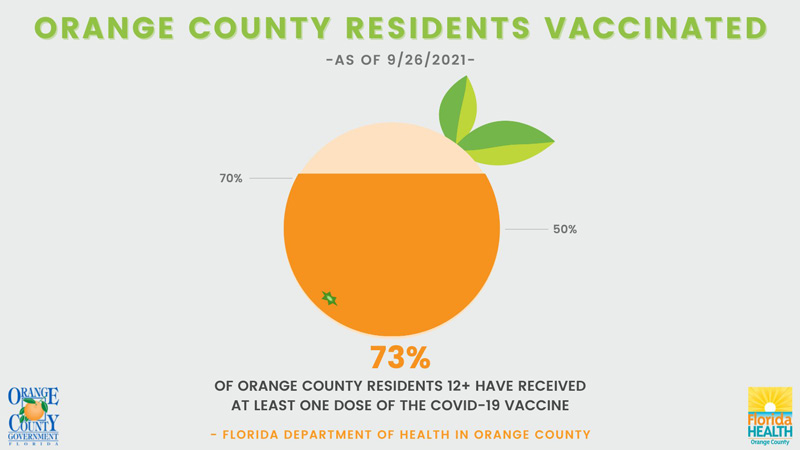Florida COVID Report: Lowest Cases Since Early July
Here’s this week’s COVID-19 report with data from Florida and around Walt Disney World as of September 28, 2021. This provides an update on new cases, positivity, hospitalizations, plus commentary from Orange County’s weekly health briefing about the record drop in the last week and potential for a holiday speak. Also, we take a look at what level the numbers need to reach before Walt Disney World considers dropping indoor mask rules.
We’ll start with the latest report from the Florida Department of Health, which shows the another significant drop in new weekly cases at 56,325. This is the lowest number in the last 10 weeks, which is how long the report dates back. Last week was the first time Florida had been under 100,000 since mid-July, and now the state is at roughly half that level. As a reminder, Florida topped 150,000 weekly cases for several consecutive weeks in August.
For the skeptics, this is not simply a result of reduced testing. Florida’s rolling positivity rate continues to decrease as well, down to 8.6%. This is another first in the last 10 weeks–Florida hasn’t had a single-digit rolling positivity rate since June. That number was 11% last week, 13.7% the previous week, 15.6% the week before that, and 17.3% four weeks ago. It had been in the 20% range for several weeks from July through mid-August.
This report shows new cases dropping in the last week among every age range, including a fourth straight week of sharply dropping numbers among school age kids eligible for vaccinations. Inoculations continue to increase among the 12-19 age cohort (now at 54%) and every age range, but have slowed significantly from their pace in August.
The highest case numbers are once again occurring in age ranges between 20 and 39 years old. Over 83% of Floridians above the age of 60 are vaccinated, plus 76% of those ages 50-59. The lowest vaccination rate is among residents ages 20-29 at 52%.
Above is a look at Florida’s daily case trend via the United States Centers for Disease Control and Prevention’s COVID Data Tracker. Per the CDC, Florida’s 3,706 new cases on Sunday is the lowest daily count since July 5, which was a day of decreased testing due to the Independent Day weekend.
The state’s 7-day average of new cases stands at 6,768 as of September 26. That’s down from over 9,000 one week ago and 12,000 the week prior. This is Florida’s lowest rolling 7-day average since July 16, which is before the most recent wave began. At its current pace, Florida will be back to its June lows when cases bottomed out within a couple weeks.
Above is a chart of Florida’s daily case data from the CDC to put this precipitous decrease into context.
After peaking in late August, daily numbers and the moving average have been falling throughout September. Again, since the positivity rate is decreasing in tandem with moving numbers, this is not a result of decreased testing. It’s also follows the visible trajectory of every past wave.
For further insight, the Florida Hospital Association continues to report a decline in new hospitalizations. The total number of hospitalizations as of yesterday is 6,366.
This number is down 25% week-over-week, and once again below 10,000. Until early September, that number was above 15,000. It’s now at less than half of the level of the late August peak.
Per numbers from the U.S. Department of Health and Human Services, coronavirus patients account for 11.77% of Florida’s inpatient beds (down from 14.99% last week and 19.25% the prior week) and 25.53% of ICU beds (down from 32.84% last week).
Despite this sharp drop in coronavirus patients, 79.04% of hospital beds in Florida are still in use (down from 82.27% last week). This is likely a mix of standard procedures resuming and the reality that hospitals normally operate at relatively high capacity even under normal circumstances (although that number has dropped in recent decades per CDC data).
Closer to Walt Disney World, both AdventHealth Central Florida and Orlando Health resumed normal operations a couple of weeks ago. During the August peak, both reached their highest status levels, restricting procedures and coming close to running out of space.
Both now have fewer than half of the coronavirus patients as August. Over 90% of the patients hospitalized for COVID-19 at Orlando Health and AdventHealth are unvaccinated.
Deaths are counted on the date they occurred rather than the date they’re reported, and it can take approximately 2-3 weeks for that to occur. This means that not only do deaths lag cases, but they are backfilled in the reporting data. It’s thus difficult to say with certainty when deaths have peaked until a month or so after the fact.
With that said, looking backwards 3 weeks shows a moving average of 249 deaths per day, which is down from the 272 number reported last week. It appears that deaths peaked in late August at around 360 per day, as September deaths are down considerably–even dates that are 2-3 weeks ago. However, those numbers will still increase over time.
Florida now ranks 33rd among states in the U.S. for average daily COVID cases per 100,000 people per data compiled by the New York Times. This is an improvement from the state’s 25nd place ranking last week, 22nd the week before that, and 10th place the week before that. For much of August, Florida held the top spot, accounting for nearly 25% of all cases in the nation at one point.
While some states are continuing to see their own surges, cases are now starting to decline throughout the Midwest, Great Plains, and Northeast as a whole. As recently as last week, these regions were seeing increases even as the South’s cases plummeted. Florida’s downward trend still outpaces almost every other state, but it’s interesting to see other states’ trends–or lack thereof–as some states are seemingly spared from the same seasonal spikes. At least, for now.
Moving along, Orange County Mayor Jerry Demings and other local leaders held their latest press conference, which you can view for yourself above. (This one is probably not worth watching.)
Dr. Raul Pino from the Florida Department of Health in Orange County spoke at the press conference, providing further insight and indicating that Orange County is “moving into a very good position.”
To support this claim, Dr. Pino stated that Orange County’s rolling positivity rate is 9.3%, down from the 20% levels of August. The weekly incidence rate is 157 positive cases per 100,000 individuals, down from the 600s of August (that’s also down from 243 last week).
During last week’s press conference, Dr. Pino stated the previous week had seen the highest ever drop in week-to-week numbers over the course of the entire pandemic, with weeks 36 to 37 showing a record reduction in cases by 30%. That record has been broken, as weeks 37 to 38 experienced a drop of ~40% in cases.
Dr. Pino noted that the death data may not seem very good, but it was very predictable and within the range of what’s normal and expected given the spike in August cases. He stated that there are probably a few more weeks of elevated death numbers before those follow the decrease in new cases and hospitalizations.
He also indicated that September deaths should be considerably lower than August, with the latter going down as the peak of the entire pandemic. (Orange County has access to its own death data, so the same lag issue described above for Florida’s death toll as a whole does not exist.)
Much of the press conference and the Q&A involved a political standoff between the mayor and governor, all of which is beyond the scope of this post. As previously mentioned, our goal here is objective and wholly depoliticized reporting on what’s happening with COVID in Florida.
One item of potential interest is that Dr. Pino was asked about the conversion of quarantined students into positive cases. He didn’t have a precise percentage, but did state that “over 90%” of quarantined students test negative. (This is also beyond the scope of this post, but follows a controversial policy change by Florida that has garnered nationwide headlines.)
Finally, Dr. Pino once again discussed the upcoming holidays and urged residents to get vaccinated ahead of that season of travel and family gatherings. He stated that while Orange County won’t be in the same position it was last year to see a huge holiday spike, there is still a risk.
As a reminder, the vast majority of COVID transmission (~70%) can be categorized as “living room spread,” which occurs as result of regular home life and household gatherings. (It’s also why one of the most effective mitigation measures is opening windows or moving events outdoors as the weather allows.)
Another local health leader (whose name I didn’t catch–sorry!) spoke about influenza, indicating it could be a significant problem and contribute to a “dual pandemic” this year. His main message was to reinforce the importance of getting the flu shot, and being “co-vaccinated” against both.
He said we don’t want to have the added burden of influenza as we head into the holidays. “Vaccination is our best opportunity to avoid getting into another situation as we saw this summer with COVID,” he said.
Former FDA commissioner Dr. Scott Gottlieb spoke with CNBC about this same topic, offering a bit more insight as to why this year’s flu season could be uniquely bad. (That’s an interesting interview worth watching–better than his appearance on Face the Nation this weekend.)
Before you write this off as fear-mongering, Dr. Gottlieb’s focus is on the economic impacts of influenza and endemic COVID. The flu already annually cost billions of dollars in productivity, but will increase further and become “too much to bear” in the years to come. He suggests upgrading offices to hospital grade air filtration, increasing access to outdoor space, improving ventilation, monitoring air quality, using remote meetings more often, and de-densifying office floor plans, among other things.
Gottlieb says this is likely the last major surge of infection during the pandemic phase, caused by Delta. Many respected epidemiologists agree, believing the end of the pandemic phase of COVID-19 is nearing, and that the virus will soon be endemic. (Some experts believe that may already be the situation in Florida following vaccinations and this summer’s wave of infections.) In other words, COVID will never go away and we’ll need to learn to live with the virus.
Much like the flu season, an annual COVID season should be expected in future years, and Americans need to prepare for that. Changes to offices, schools, and other settings that improve air filtration and ventilation are the most significant changes that can be made to address this.
Finally, although the sharp decline throughout Florida is encouraging, Orange County is still in the “high” level of the CDC’s Community Transmission Map. If current trends hold, Orange County will move to the “substantial” level as soon as next week.
With that said, the CDC’s criteria for moving down to the moderate level where face masks are no longer recommended indoors is under 50 total new cases per 100,000 persons in the past 7 days and under 8% test positivity during the past 7 days. Even assuming Orange County continues on its record trajectory from last week, it would still be sometime in mid-October before it hits the moderate level.
Walt Disney World reinstated its indoor mask rule with that CDC guidance, so it’s likely Disney won’t lift the rule until Orange County qualifies for the moderate level. It’s also possible Walt Disney World won’t lift the current mask rules until after the holiday season, waiting to see a sustained downturn throughout the United States. If current trends hold, Disneyland would qualify for lifting the rule first, as California’s Orange County already has a qualifying (low level) positivity rate and is just waiting on its case rate to hit the moderate level. It’s worth noting that, previously, Disney changed the rules for both Walt Disney World and Disneyland simultaneously, without regard for the specific circumstances in their respective states and counties.
Planning a Walt Disney World trip? Learn about hotels on our Walt Disney World Hotels Reviews page. For where to eat, read our Walt Disney World Restaurant Reviews. To save money on tickets or determine which type to buy, read our Tips for Saving Money on Walt Disney World Tickets post. Our What to Pack for Disney Trips post takes a unique look at clever items to take. For what to do and when to do it, our Walt Disney World Ride Guides will help. For comprehensive advice, the best place to start is our Walt Disney World Trip Planning Guide for everything you need to know!

